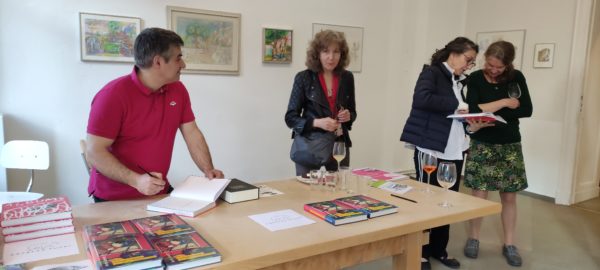BERLIN — On May 8 artists, art lovers and friends of the artist gathered at the Galerie Wolf & Galentz in Berlin to celebrate the publication of Archi Galentz’s book, Stellungnahmen zu allem Unmöglichen, translated, roughly, as Statements on Everything Impossible.
Galentz, who comes from a family of Armenian artists, was born and brought up in Moscow, then studied under Klaus Fussman at the Academy of Arts in Berlin, where he now resides. Influenced by artistic traditions of both east and west, he has stressed the social and political relevance of art and has become known informally as a cultural ambassador of Armenia in Germany.
In her welcoming remarks, the editor of the volume, Anne E. Wilkins, said that she had racked her mind for the right expression to describe Galentz, and what she came up with was “a phenomenon.” After listing the many things he has done, his vast network of acquaintances and activities, his achievements as a versatile artist, she felt she still had not hit the nail on the head. “Resistance” then came to mind as an apt term; unimpressed by art canons, he considers prevailing viewpoints, whether in the arts or in politics and society, with healthy skepticism and he resists pressures of the art market as well as political ideologies. Galentz’s book, she concludes, provides the only means to adequately grasp the essence of his work.

Mapping a Mind
In point of fact, the book which is far more than a catalogue, offers unique insight into who Archi Galentz is, and how he has come to be who he is. Reading this rich 320-page volume is like rotating one of the huge cubes that he has created — what he has entitled “Globus” (Globe) — cubic constructions with maps on each of the six surfaces. But the book is a larger, more complex polygon, actually a dodecahedron with twice as many sides. We move from one facet to the next, thematically tracing the journey of the artist in his first 50 years. With each rotation, we meet a new facet of his personality, as painter, designer, engraver, collector, curator, gallerist, photographer, Arrièregardist — each identity presented now by his professor or a fellow artist, now in a late-night dialogue with a gallerist, but mostly in his own words, in autobiographical reflections. The process unfolds in twelve chapters, each richly illustrated with single works, photographs of (solo and group) exhibitions, documenting the seemingly endless variety of artistic media Galentz has explored, in an incessant experimentation with ideas and forms. As encapsulated in his engagement with cartography, it is a matter of investigating identity through transformation — historical, national and very personal. The catalogue itself is an artistic product bearing the signature Galentz.
Creations of Chance










